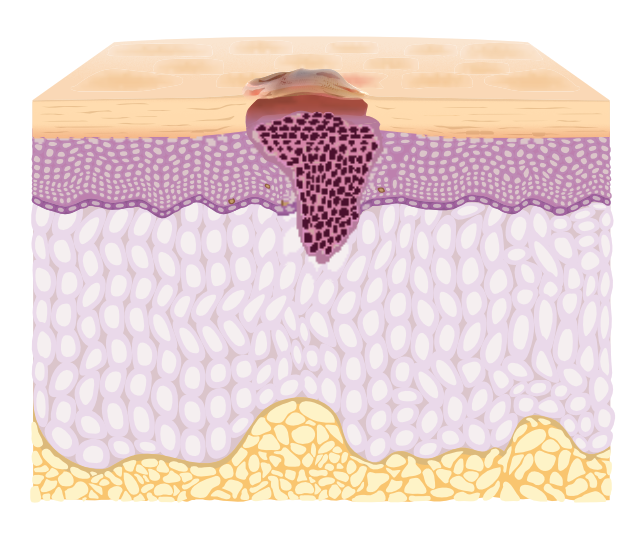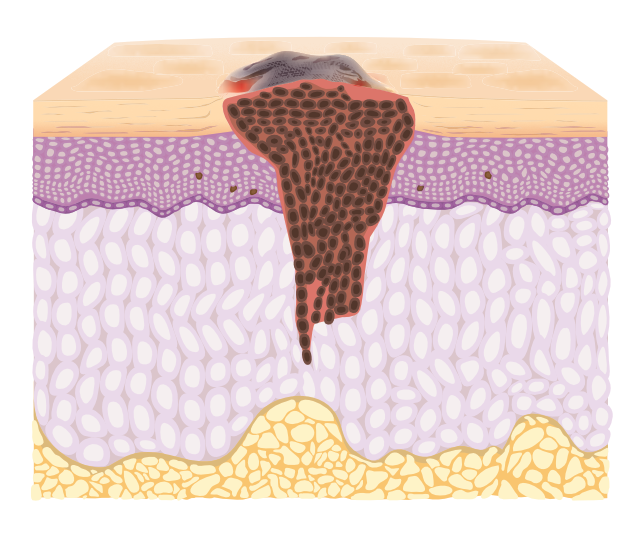

Tumor DNA Mutations



Cell-free DNA (cfDNA) is non-encapsulated DNA present in the bloodstream, with a portion originating from a tumor clone.
cfDNA enters the bloodstream via apoptosis or necrosis, and contains the DNA mutations characteristic of the tumors from which it originates.
With the emergence of powerful technologies including next-generation sequencing (NGS), cfDNA analysis may enable cancer screening, detection, and monitoring via liquid biopsy.
Machine learning offers a solution for analyzing the enormous amount of data produced by screening technologies, and is being applied to identify patterns and markers that would otherwise be missed by technicians and physicians.
Combining a liquid biopsy with machine learning offers a less invasive alternative to tissue biopsy and imaging, and could simplify monitoring with repeated, minimally invasive blood samples.
One of the challenges of incorporating machine learning is that it relies on training with representative samples. The algorithm is adjusted and improved as more data is entered, enabling better decision-making. Large-scale studies are underway to create a library of cancer mutations from cfDNA data that may be used to train algorithms.

Detecting Tumor DNA Mutations
goes to...
Artificial Intelligence
AI offers clear advantages for analyzing enormous amounts of sequencing data. However, the success of machine learning and liquid biopsy for cancer screening, detection, and monitoring will depend on the development of large libraries of genetic information and algorithm training.

Learn more here:
www.grail.com
www.quantgene.com
Heart Disease



The echocardiogram is widely used to evaluate atherosclerosis, cardiomyopathy, heart failure, aneurysm, and more. Different types of echocardiography are used to assess cardiac wall thickness (M-mode) and blood flow through the heart (Doppler), as well as 2-D and 3-D methods to visualize the motion of heart structures. Images must be obtained by skilled echocardiographers, and interpretation of the multi-view format is complex and time-consuming, and requires the expertise of a cardiologist.
AI has the potential to overcome some of these challenges, and a recent study examined the ability of a convolutional neural network to classify standard views based on still images and videos from hundreds of echocardiograms. Convolutional neural networks are deep learning algorithms often applied to image recognition and classification, that are able to assign importance to aspects or objects in the image and differentiate one from another. This model demonstrated nearly 98 percent accuracy.

Heart Disease Diagnosis
goes to...
Physicians
Despite the overall success of this model, classification of a single image is not sufficient for a diagnosis. This is a very promising step, however, and with further development, AI may one day be capable of analyzing echocardiograms to aid in diagnosing heart disease.

Learn more here:
www.nature.com
Myocardial Infarction



Myocardial infarction (MI) is one of the leading causes of morbidity and mortality in the United States. There are numerous modifiable risk factors including cardiovascular fitness, blood glucose, hypertension, body mass index, and smoking, however a significant number of MIs occur among individuals who are not considered high risk. As such, implementing a predictive tool may enable physicians to intervene sooner, potentially delaying or preventing an MI.
Several studies have explored the utility of AI for predicting MI, with promising outcomes. When used to examine routine clinical data from family practices, machine learning algorithms—with neural networks being the highest achieving—improved prediction of a first cardiovascular event over established algorithms. Similarly, a deep learning model was used to evaluate myocardial perfusion polar maps for identification of patients who develop adverse cardiovascular events. It has also been used to analyze coronary CT angiography and was better able to discriminate patients who subsequently experienced an adverse event compared to Coronary Artery Disease Reporting and Data System (CAD-RADS) score.

Myocardial Infarction Prediction
goes to...
Draw
It is important not to overlook modifiable risk factors, however, AI may be especially valuable for initiating early intervention among patients not considered high risk. A major hurdle will be privacy, especially for methods that rely on examining confidential clinical data.

Learn more here:
www.ncbi.nlm.nih.gov
esc365.escardio.org
journals.plos.org
Skin Cancer




Skin cancer is prevalent, and early detection is critical for survival. Melanomas are especially dangerous, as they account for almost three-quarters of all deaths related to skin cancer.
Diagnosis is mainly achieved through visual screening, which creates an opportunity for image analysis with AI. A recent study examined the classification of skin lesions using a single deep convolutional neural network compared to classification by board-certified dermatologists. Images included keratinocyte carcinomas (the most common skin cancers) and malignant melanomas (the deadliest skin cancers), and performance was comparable between the convolutional neural network and dermatologists.

Skin Cancer Detection
goes to...
Draw
AI has the potential to make skin cancer screening highly accessible, especially when combined with smartphones. Algorithm training remains a challenge, as images used for this purpose are often obtained under ideal conditions, whereas smartphone cameras may capture images in different lighting or varying background conditions. Further, dermatologists rely on several other factors for diagnosis, including evolution of the lesion, skin type, skin cancer history, sun protection, etc. It is possible that AI will serve as an excellent tool to support dermatologists and direct patients to seek a medical opinion.

Learn more here:
www.nature.com
Intensive Care



Physicians working in intensive care units are under enormous pressure to make life-saving decisions under strict time constraints, and synthesize large amounts of physiologic data. Nurses must also be vigilant, frequently checking in and monitoring patients—which becomes difficult during periods of high patient census. The potential for AI in intensive care is in continuous monitoring and prediction.
Machine learning systems to analyze flow and pressure waveforms from ventilators to detect patient-ventilator asynchrony, and automated fluid management systems have already been developed for investigational use. Asynchrony is associated with increased mortality and longer hospital stays, and fluid overload may increase the length of ICU stays.
Sepsis is also a leading cause of mortality among hospitalized patients, however, prediction is difficult and requires time-consuming laboratory tests. A machine learning classification system that uses multivariable combinations of patient data (such as vitals, peripheral capillary oxygen saturation, age, etc.) has been shown to accurately forecast sepsis onset, and is compatible with various electronic health record systems. Earlier prediction would enable intervention and therapy to potentially prevent the onset of sepsis.

Monitoring and Prediction in Intensive Care
goes to...
AI
Continuous monitoring and early prediction could serve to support intensive care physicians in decision-making, and alleviate nurses of some of the burden of continuous monitoring. However, there are challenges ahead for implementing AI in the ICU. While incorporating AI may support decision-making, it is ultimately the physician who is held accountable. Additionally, continuous monitoring may necessitate consent for data collection, however many patients in intensive care are unable to provide consent until they have recovered.

Learn more here:
www.autonomoushealthcare.com
www.dascena.com
medinform.jmir.org
Suicide Risk


Ever increasing suicide rates have prompted the government, health care systems, and even corporations to invest in prevention. Symptom underreporting and timing make risk identification challenging, and there is increasing reliance on AI to determine risk.
There are two general approaches to implementing AI for suicide prevention. The first relies on medical records and individuals already in contact with various health services. A study examining machine learning applied to electronic health records demonstrated its ability to accurately predict future suicide attempts, and a separate study examining the feasibility of artificial neural networks used with electronic health records demonstrated similar accuracy to other published methods such as questionnaires. An alternative approach is AI analysis of behaviors based on social media and smartphone apps, for example, Facebook has implemented an algorithm to detect signs of self-harm.

Assessing Risk of Suicide
goes to...
Draw
Given the challenges associated with risk identification and suicide prevention, additional tools to support this effort are certainly valuable. There are several difficulties associated with implementing AI for this purpose, with privacy being a primary concern. AI used within the health care system relies on medical records, which are protected by various laws and regulations, however this does not apply to information obtained via social media. Safety is also a concern, as AI programs must be capable of generating an appropriate response to users that does not exacerbate the situation, and response protocols must be developed to address individuals marked as high risk by AI technology.

Learn more here:
journals.sagepub.com
www.ncbi.nlm.nih.gov
newsroom.fb.com/


